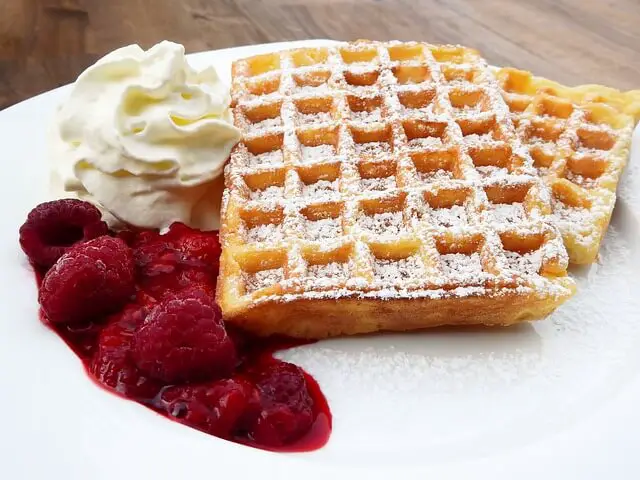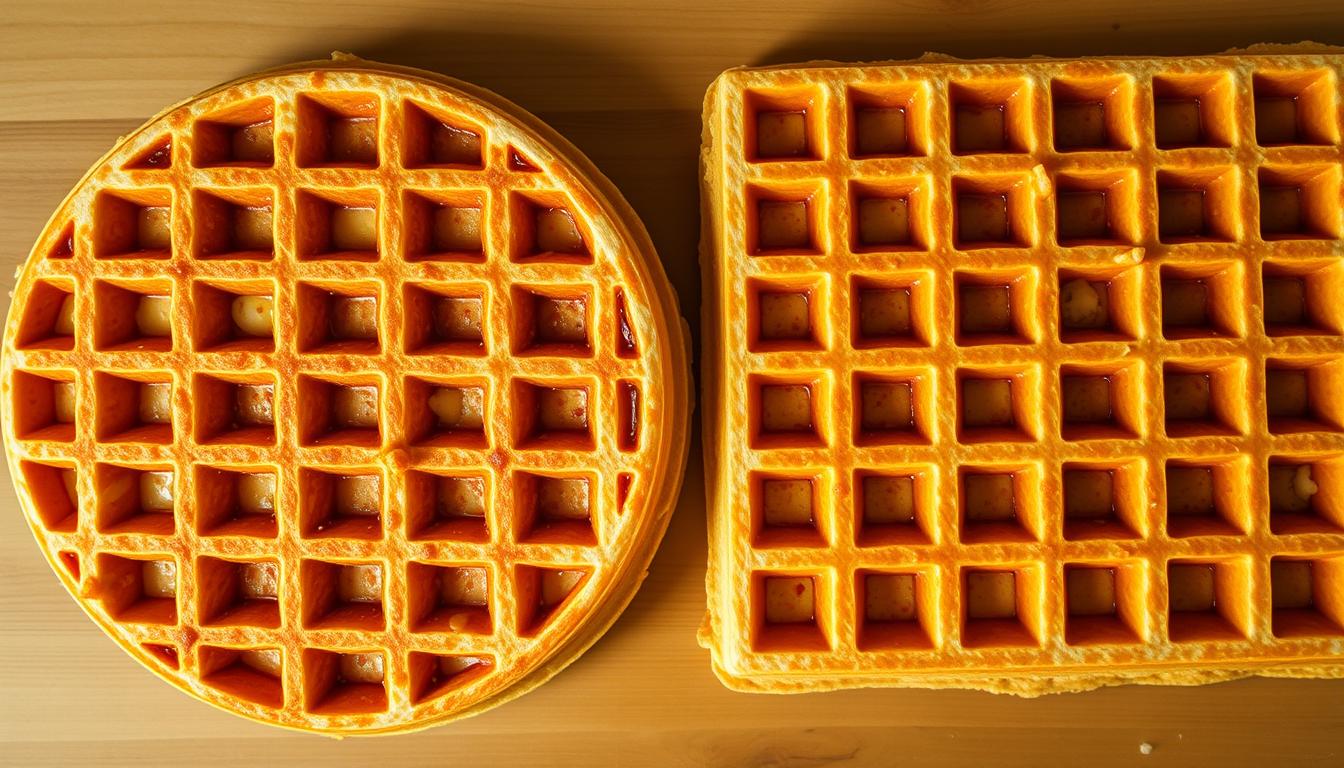Breakfast is one of the most important meals of the day, and it’s always a good idea to have something that’s both filling and tasty.
Two classic breakfast foods that fit this description are waffles and french toast. I’ll take a look at each dish in turn and compare them in terms of:
- Nutrition
- Taste
- Ease of making
- Time to prepare
- Cost
- Availability
- Dietary considerations
- Health benefits
- Regional variations
Nutritional Value
When it comes to nutrition, you may be surprised by the differences between these two beloved breakfast staples. Waffles and French toast have many similarities in terms of ingredients list, as both require eggs, sugar, milk, and a few other basic ingredients. However, they differ in texture comparison and cooking methods; waffles are light and crisp while french toast is soft and creamy.
Calories
While waffles and French toast are two classic breakfast staples that have been enjoyed by people around the world for generations, there is a clear winner when it comes to calorie count. A single waffle typically contains fewer calories than a piece of French toast, and the reason for this lies in the way that bread absorbs liquid.
When making French toast, bread is soaked in an egg mixture before being cooked on a griddle or in a pan. During this process, the bread absorbs more of the mixture than it would if simply toasted. This means that each slice of French toast contains more calories as compared to plain toast or waffles which are not subjected to soaking in any liquid.
On the other hand, waffles are made using batter which is poured into a preheated waffle iron where it solidifies and crisps up into fluffy golden brown pockets.
Protein
Also a waffle has more protein than a piece of French toast. The question then arises: why is this the case? The answer lies in the ingredients used to make each dish.
There are several reasons for this disparity. First and foremost, waffles are made with a batter that includes eggs, which are rich in protein. In fact, a typical waffle recipe may call for anywhere from one to three eggs per batch. By contrast, French toast typically involves dipping slices of bread into an egg-and-milk mixture before frying them up on the griddle. While this does add some protein to the dish, it generally falls short of what you would get from a comparable serving of waffles.
Calcium
Waffles and French toast both contain calcium, which is essential for strong bones and teeth. However, did you know that waffles have more calcium than a piece of French toast? The reason for this lies in the ingredients used to make each dish.
Waffles are made using a batter mix consisting of flour, eggs, milk, and other ingredients. Milk is a key ingredient in making waffle batter, and it contains high amounts of calcium. This makes waffles a good source of calcium as compared to French toast which typically uses bread dipped in an egg mixture with milk added for flavor. While milk is also used to make the egg mixture for French toast, it is not enough to match the amount of calcium found in a typical waffle recipe because while some of the calcium from the milk may be absorbed by the bread during this process, it is not as concentrated as it is in waffle batter.
Carbohydrates
Many people are surprised to learn that waffles contain more carbohydrates than French toast. Both breakfast favorites are made with similar ingredients such as eggs, milk, and bread, but there are some key differences that affect their nutritional values.
Firstly, waffles typically have a higher ratio of flour to liquid compared to French toast. This means that waffle batter is thicker and more dense than the egg mixture used for French toast. The extra flour contributes to a higher carbohydrate count per serving.
Secondly, waffles are often served with syrup or other sweet toppings which can significantly increase their carbohydrate content. Even if you opt for sugar-free syrup or topping alternatives, it’s important to keep in mind that these options may still contain carbohydrates.
Also many restaurants and grocery stores sell pre-made frozen waffles which often have added sugars and preservatives that can further increase their carbohydrate count.
Fats
Many people may be surprised to learn that a waffle typically contains more fat than a piece of French toast. So why is this the case?
Firstly, waffles are made with a batter that usually includes ingredients such as butter and oil. These ingredients help to give the waffle its classic texture and flavor but also contribute significantly to its fat content. In contrast, French toast is typically made using beaten eggs mixed with milk or cream – ingredients which contain less fat compared to butter and oil.
Another factor contributing to the higher fat content in waffles is the way they are cooked. Waffles are traditionally cooked on a hot griddle or in a specialized waffle iron that requires significant amounts of butter or oil to prevent sticking.
Both dishes offer plenty of pairing ideas for toppings such as fruits, syrup or honey.
On the other hand, french toast requires less topping options since it’s already naturally sweetened by the egg mixture that coats it before frying. The nutritional value of these two classic breakfast foods can depend highly on how it’s prepared and what toppings you add—so if you’re looking for a healthier option then consider making your own at home where you can control exactly what goes into them!
Taste
You’ll be amazed by the difference in taste – french toast is like a sweet cloud of heaven compared to a waffle’s savory crunch. Waffles have a unique texture and flavor that sets them apart from other breakfast foods, while french toast is made with bread dipped in eggs and milk.
When it comes to adding spices, you can use cinnamon, nutmeg, or cardamom for a richer flavor with French toast, while waffles are usually just spiced with sugar. The texture variation between the two is also worth noting – the crunchy yet fluffy exterior of waffles gives way to an airy lightness inside that you won’t find in french toast.
When it comes to toppings ideas, both options offer lots of variety. For a sweeter take on either dish, try adding maple syrup or honey; for something savory go for bacon or sausages; if you’re feeling really brave, top your waffle or french toast off with some melted cheese!
Presentation-wise too there is plenty of choice – you could try stacking your creations high on a plate or serving each one up individually as part of a brunch platter.
No matter what combination you choose, both waffle and french toast give you an opportunity to get creative with flavors and presentation styles. You’ll want to consider:
- Sweet vs Savory: Choose whether you want something rich and indulgent or lighter fare when deciding which dish to make.
- Spices: Experiment with different spice combinations for added depth of flavor.
- Toppings Ideas: Get creative with toppings such as fruits, nuts, or chocolate chips.
- Presentation Options: Stack them high on a plate or serve each one individually as part of a brunch platter.
- Consider different cooking techniques to bring out the best flavor in the dish, such as baking, grilling, or sautéing.
Ease of Making
Making waffles and french toast are both easy, but you’ll find one’s a bit simpler than the other.
When it comes to calorie counting, for example, waffles can be made with just a few basic ingredients – flour, sugar, milk or water and eggs. Depending on your texture preferences, you can adjust how much sugar or liquid you add to make them either light and crispy or thick and fluffy.
With french toast, however, there’s an extra step of dipping the bread into the egg mixture before cooking. This makes it more time-consuming if you need to make breakfast in a hurry.
When it comes to vegan substitutions for waffle and french toast recipes, there are many options available that involve swapping out eggs or milk for plant-based alternatives like flaxseed meal or almond milk. Similarly, when it comes to serving tips for each dish, there are many options; from savory toppings like bacon and avocado to sweet ones like fruits and syrup – the choice is yours!
When making either of these classic breakfast foods at home, there are some important things to consider; such as using non-stick cookware so they don’t stick while cooking. Also avoid overfilling the waffle maker since this will cause them not to cook evenly!
Time to Prepare
Cooking up a batch of waffles or french toast can take as little as 10 minutes, making them ideal for those busy mornings. However, when it comes to preparing these breakfast favorites, there are some differences that may change the time needed to prepare them.
When it comes to waffles, they’re fairly easy to store as leftovers if you have any since they cool quickly and can be easily wrapped in plastic wrap and stored in the refrigerator or freezer. If not, serving suggestions such as adding fruit, nuts, syrups, or whipped creams can add a few extra minutes of preparation time before eating.
As for presentation ideas, waffle makers come with various shapes and sizes, which allows you to create fun designs that will delight your guests with minimal time spent in preparation.
French toast takes a bit more work due to its texture differences compared to waffles, which requires soaking the bread slices into an egg mixture before cooking on a skillet. Topping ideas such as fruits or powdered sugar also require additional time for planning and presentation purposes.
Cost
Cost-wise, you can’t beat the savings of making waffles or french toast yourself – it’s a real bang for your buck! With just a few simple ingredients like eggs and flour, you can make either dish on a budget. You can find low cost alternatives to organic options in many stores, as well as pre-made mixes for those looking for convenience. Gluten-free choices are also available in some stores when it comes to buying ready-made versions of these two breakfast staples.
When it comes to creating these dishes at home, there are even more opportunities to save money by using basic pantry items like milk and sugar. Not only do these common kitchen staples provide tasty results, but they also help keep costs down. If you’re feeling adventurous, you may even be able to create your own recipe with whatever ingredients you have handy.
Making waffles or french toast from scratch is an inexpensive way to enjoy a delicious breakfast that’s sure to please any palate. Plus, it gives the cook the satisfaction of knowing exactly what goes into their food – something that store-bought varieties often don’t provide.
Versatility
Creating these dishes is a breeze, offering plenty of versatility to please any palate! Waffles and french toast are two breakfast favorites that can easily adapt to different dietary needs. For those who want to cut down on calories, both waffles and french toast can be made with whole wheat bread or egg whites. If you’re looking for more indulgence, both dishes can also be topped with butter, syrup, fresh fruit, jams, or nut butters.
When it comes to texture differences between the two dishes, waffles have a crispier exterior due to their grooved surface, which allows them to absorb more syrup than french toast. Conversely, french toast has a softer interior resulting from its longer cooking time in the pan. The taste may vary depending on the type of bread used in each recipe; however, both provide delicious and savory outcomes when cooked correctly.
Also freezing these dishes is an excellent way to keep them fresh longer while still being able to enjoy them during busy mornings – simply pop one in the microwave, and voila! The topping variations are nearly endless; whether you prefer something sweet like whipped cream and chocolate chips or something savory like bacon bits and cheese – there’s really no wrong way to assemble your perfect breakfast plate.
Availability
Both waffles and French toast are widely available in many supermarkets, either as pre-made mixes or ingredients to make them from scratch. They can be found almost everywhere around the world in restaurants and cafes. In some countries, you can even get creative with the recipes – for example, Indian restaurants offer savory versions of both dishes.
Whether it comes to making waffle or French toast batter at home or picking up a premade mix off the shelf, there’s no shortage of options when it comes to these two classic breakfast foods.
In addition to being readily available at supermarkets and restaurants, these two breakfast staples also make great side dishes for other meals. For instance, ordering waffles or French toast as a side dish in an American diner is a popular choice – especially for those who want something sweet alongside their meal. Waffles also pair well with savory entrees like fried chicken and eggs while French Toast can be served with sausages and bacon.
Dietary Considerations
When it comes to dietary considerations, both of these breakfast options offer something for everyone – whether you’re vegan, gluten-free, or just looking to switch up your morning routine.
Waffles can be made with a variety of seasonal ingredients and are often served with vegan alternatives such as plant-based butter and dairy-free toppings. Also there are plenty of allergen-aware waffle recipes that cater to those who have sensitivities or allergies to wheat or dairy products.
French toast is also popular among those following vegan diets as it is easily made with plant-based milk substitutes and other vegan alternatives. Also gluten-free breads can be used when making french toast which makes it an ideal option for people with celiac disease or gluten sensitivity.
Breakfast trends come and go but one thing remains certain: both waffles and french toast will always remain staples in the breakfast world due to their versatility in terms of dietary restrictions. While each dish has its own unique flavor profile and texture, they can both accommodate a variety of different tastes and preferences. Whether you choose one over the other depends entirely on your individual preference—but rest assured that either will make for a delicious start to your day!
Health Benefits
Both waffles and french toast can provide a number of health benefits, making them an ideal choice for a balanced breakfast. For starters, both meals offer the opportunity for portion control as well as calorie counting. This means that you can adjust the amount of each ingredient to fit your needs without sacrificing flavor or texture.
Also if you’re dealing with food allergies, either option can easily be adapted to fit your dietary restrictions by using alternative ingredients like gluten-free flour or vegan milk. Also waffles and french toast offer plenty of versatility when it comes to customizing the meal according to one’s taste preferences.
You can add toppings like fresh fruit or nuts to make it even more nutritious while still keeping it delicious. And since they’re both quick and easy to prepare, they make great time-saving breakfast options for busy mornings.
Regional Variations
Waffles and French toast are like two sides of the same coin, with each boasting unique regional variations across the globe. From sourdough differences between Belgian waffles to quick-cook options for French toast, there is an endless array of flavor combinations that can be created in breakfast dishes.
The savory toppings used to enhance waffles around the world range from cheese and bacon in Portugal to spicy bean chili in Mexico. On the other hand, French toast ranges from sweet accompaniments such as honey, maple syrup, or even jam – depending on where you are – to egg variations like custard-soaked brioche or challah bread.



